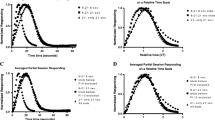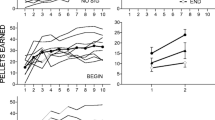Abstract
After immediate, response-dependent reinforcers were delivered for the first three key pecks made by experimentally naive pigeons, a variable-time schedule of response-independent reinforcement maintained key pecking. This result also was reported by Neuringer (1970). A stimulus change did not follow any key peck, and as a result the experiment demonstrated that response maintenance was not due to conditioned reinforcing effects of a light flash that was produced by each key peck in Neuringer’s experiment. An analysis of the temporal relation between responses and response-independent reinforcers showed that absolute temporal contiguity rarely, if ever, occurred. The data further suggest that any appeal to adventitious temporal contiguity in accounts of superstitious conditioning must be refined to include specification of actual temporal response-reinforcer relations and a modified definition of “contiguous.”
Similar content being viewed by others
References
APPEL, J. B., & HISS, R. H. (1962). The discrimination of contingent from non-contingent reinforcement. Journal of Comparative and Physiological Psychology, 55, 37–39.
FENNER, D. (1980). The role of contingencies and “principles of behavioral variation” in pigeons’ pecking. Journal of the Experimental Analysis of Behavior, 34, 1–12.
FLESHLER, M., & HOFFMAN, H. S. (1962). A progression for generating variable-interval schedules. Journal of the Experimental Analysis of Behavior, 5, 529–530.
GLEESON, S. (1987). Degraded response-reinforcer relations: Effects of dependency and temporal contiguity. Unpublished doctoral dissertation, West Virginia University, Morgantown.
GLEESON, S., & LATTAL, K. A. (1988). Response-reinforcer relations and the maintenance of behavior. Journal of the Experimental Analysis of Behavior, 48, 383–393.
HAMMOND, L. J. (1980). The effect of contingency upon the appetitive conditioning of free-operant behavior. Journal of the Experimental Analysis of Behavior, 34, 297–304.
HENTON, W. W., & IVERSEN, I. H. (1978). Classical conditioning and operart conditioning. New York: Springer-Verlag.
HERRNSTEIN, R. J. (1966). Superstition: A corollary of the principles of operant conditioning. In W. K. Honig (Ed.), Operant behavior: Areas of research and application (pp. 33–51). New York: Appleton-Century Crofts.
HURSH, S. R., NAVARICK, D. J., & FANTINO, E. (1974). “Automaintenance”: The role of reinforcement. Journal of the Experimental Analysis of Behavior, 21, 117–124.
LATTAL, K. A., & MAXEY, G. C. (1971). Some effects of response independent reinforcers in multiple schedules. Journal of the Experimental Analysis of Behavior, 16, 225–231.
NEURINGER, A. J. (1970). Superstitious key pecking after three peck-produced reinforcements. Journal of the Experimental Analysis of Behavior, 13, 127–134.
RACHLIN, H., & BAUM, W. M. (1972). Effects of alternative reinforcement: Does the source matter? Journal of the Experimental Analysis of Behavior, 18, 231–241.
RESCORLA, R. A., & SKUCY, J. C. (1969). Effect of response-independent reinforcers during extinction. Journal of Comparative and Physiological Psychology, 67, 381–389.
RICHARDS, R. W. (1981). A comparison of signaled and unsignaled delay of reinforcement. Journal of the Experimental Analysis of Behavior, 35, 145–152.
SIZEMORE, O. J., & LATTAL, K. A. (1978). Unsignalled delay of reinforcement in variable-interval schedules. Journal of the Experimental Analysis of Behavior, 30, 169–175.
SKINNER, B. F. (1948). “Superstition” in the pigeon. Journal of Experimental Psychology, 38, 168–172.
STADDON, J. E. R., & SIMMELHAG, V. L. (1971). The “superstition” experiment: A reexamination of its implications for the principles adaptive behavior. Psychological Review, 78, 3–43.
WILLIAMS, B. A. (1983). Revising the principle of reinforcement. Behaviorism, 11, 63–88.
ZEILER, M. D. (1968). Fixed and variable schedules of response-independent reinforcement. Journal of the Experimental Analysis of Behavior, 11, 405–414.
Author information
Authors and Affiliations
Rights and permissions
About this article
Cite this article
Gleeson, S., Lattal, K.A. & Williams, K.S. Superstitious Conditioning: A Replication and Extension of Neuringer (1970). Psychol Rec 39, 563–571 (1989). https://doi.org/10.1007/BF03395084
Published:
Issue Date:
DOI: https://doi.org/10.1007/BF03395084




